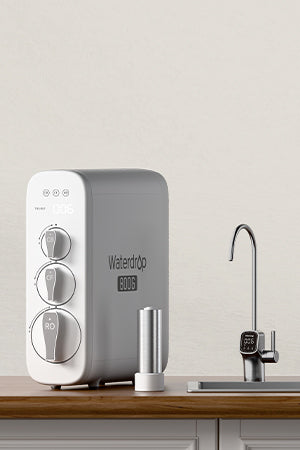L'eau, souvent considérée comme l'élixir essentiel de la vie, est un besoin quotidien. Nous l'utilisons pour cuisiner et nous laver, et nous ne pouvons pas vivre sans elle. Cependant, une eau impropre au goût peut avoir des effets néfastes sur plusieurs aspects. Quelle est la saveur de l'eau et quelle est la raison sous-jacente de son goût ? Après avoir compris les nombreux facteurs contribuant à son goût désagréable, sucré et potentiellement turbide, investir dans un filtre à osmose inverse
Waterdrop pour un usage domestique semble logique.
L’eau a-t-elle un goût ?
Nombreux sont ceux qui affirment que l'eau est dépourvue de saveur particulière. En effet, il s'agit d'une entité qui n'est pas intrinsèquement destinée à avoir une saveur. Or, ce n'est que rarement le cas pour la plupart des personnes qui consomment quotidiennement de l'eau du robinet ou du puits. En échantillonnant l'eau de différentes sources, on constate des nuances de saveurs. Certaines peuvent être véritablement répugnantes, tandis que d'autres ne laissent qu'un léger arrière-goût.
L'eau a un goût particulier dû à son absence d'eau pure. Diverses substances y sont dissoutes ou introduites lors de son traitement afin d'inhiber la prolifération des bactéries et autres substances organiques. Chacun possède des récepteurs gustatifs différents et des capacités de traitement des informations sensorielles différentes, ce qui explique le goût différent de l'eau pour chacun. L'un peut la percevoir comme pure et cristalline, tandis qu'un autre la trouvera plus désagréable.
Les raisons des goûts étranges dans votre eau
Bien que la perception du goût désagréable soit subjective, de nombreuses personnes soulignent les aspects négatifs lorsqu'on les interroge sur le goût de l'eau. Ce goût provient de trois sources principales : les minéraux présents dans l'eau, les additifs présents dans le système de traitement et les résidus provenant des canalisations et autres installations. Ce dernier point relève essentiellement de la responsabilité du propriétaire, et la seule façon d'y remédier est d'améliorer la plomberie.

Les deux premiers facteurs dépendent de l'origine géographique et de l'utilisation des ressources en eau. Ceci s'applique également à l'eau en bouteille. La concentration en minéraux de l'eau et la concentration en produits chimiques nécessaires à sa salubrité sont quantifiées en parties par million. Les substances courantes qui
altèrent le goût de l'eau comprennent le bicarbonate, le magnésium, le calcium, le fer, le chlorure et les sulfates. D'autres composants peuvent également être présents, notamment le sel, le potassium et plusieurs autres substances.
L'eau distillée est la seule eau exempte de minéraux et autres particules. Sa consommation quotidienne est déconseillée, même si elle est finalement pure. Les minéraux sont essentiels au maintien d'une santé optimale. Cet argument plaide fortement en faveur des filtres à osmose inverse, qui éliminent efficacement les contaminants tout en préservant les avantages d'une eau potable propre.
Le goût de l’eau sucrée : pourquoi est-ce ainsi ?
L'eau a un goût agréable car elle contient des minéraux. Aucun sucre n'a été ajouté à l'eau du robinet ni à l'eau potable distribuée aux particuliers ou aux professionnels. Le fait de choisir une bouteille de jus plutôt que de l'eau pure au magasin n'était pas un accident. Ce goût peut être attribué à une surabondance de fer et de calcium dans l'eau.
Il existe d'autres options. L'eau peut avoir un goût sucré si vous venez de consommer un aliment très salé ou amer. En cas de déshydratation sévère et de soif intense, le goût de l'eau peut être amplifié. Les personnes
diabétiques peuvent également rencontrer ce phénomène.
Goût et turbidité : les causes de l'eau trouble
Un goût désagréable peut parfois accompagner la turbidité. La clarté de l'eau est déterminée par la présence de particules en suspension, qui peuvent la rendre trouble ou claire. Si l'eau du robinet manque de clarté, votre compagnie des eaux peut émettre un avertissement vous demandant de la faire bouillir ou de ne pas la consommer pendant une durée déterminée. Ce phénomène peut également se produire avec l'eau. Néanmoins, il vous incombe de superviser toute amélioration. Quelle que soit la solution utilisée ou la durée du délai d'attente, des inquiétudes concernant la qualité de l'eau peuvent persister, notamment si elle présente une odeur de chlore ou de produits chimiques.
Les principaux facteurs contribuant à la turbidité sont la présence de limon provenant de l'approvisionnement en eau ou du système de traitement, résultant d'une filtration inadéquate ou du développement de matière organique. Ces facteurs peuvent avoir un impact significatif sur la saveur de l'eau et sa valeur nutritionnelle.
Les excès de minéraux, les produits chimiques de traitement et les particules turbides contribuent au goût et à l'odeur indésirables de l'eau, qui devient ainsi impropre à la consommation, à la cuisson et au lavage. Améliorez la qualité de l'eau en utilisant un filtre à osmose inverse. Un large éventail d'alternatives est disponible pour différents environnements, allant des grands filtres à osmose inverse capables de traiter une maison entière aux plus petits, parfaits pour une salle de pause au bureau.
Comment le goût de l'eau peut être modifié par un filtre à eau à osmose inverse
Si vos réponses à la question sur le goût de l’eau ne vous plaisent pas, un système d’osmose inverse peut être le choix optimal pour vous.
De nombreuses personnes préféraient la saveur de l'eau du robinet ou du puits. Elles ont alors eu recours à des bouteilles d'eau coûteuses, ce qui a donné lieu à des litiges environnementaux en raison du volume important de bouteilles en plastique.
Cependant, le goût doit être plus irréprochable et plus net. De plus, il est nécessaire de résoudre le problème de l'approvisionnement en eau bouillante pour les besoins domestiques ou de l'accès à l'eau potable pour l'hygiène personnelle, les soins aux enfants et aux animaux, la lessive et la vaisselle. L'utilisation de systèmes d'osmose inverse sous évier ou de systèmes de filtration d'eau domestiques peut éliminer efficacement la présence d'eau au goût désagréable.









































































